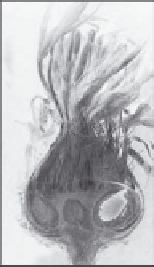Environmental Engineering Reference
In-Depth Information
Fig. 6.11
(a) Docu-
mented (solid lines) and
postulated (dotted
lines) direct and
indirect effects
associated with gallfl ies
introduced to control
knapweed (b). The fl ies
have not controlled the
weeds, and have
become superabundant
on their specialized
hosts, with a positive
effect on their deer
mice predators (c) and a
possible increase in the
risk to humans of
Hanta virus. The
knapweeds compete
with native plants
(negative effect) and
provide food for the
deer mice (positive
effect). The increased
deer mice population
may have negative
consequences for native
plants (seed predation),
native insects (preda-
tion) and other small
mammals (competi-
tion). They may also
have a positive effect as
food for larger
predators. (From
Pearson & Callaway,
2003.)
(b)
(a)
Humans
-
Hanta virus
Predators
+
+
-
Small
mammals
Deer mice
-
(c)
+
-
Native
insects
Gallflies
+
-
Native
plants
Knapweeds
being particularly susceptible. Their recommendations for management included the
avoidance of generalist control agents, an expansion of host-specifi city testing and
the need to incorporate more ecological information when evaluating potential bio-
logical control agents. Bourchier (2003) showed how this could be done in an analy-
sis of the risk to 153 nontarget butterfl y species in Canada of the release of the
parasitoid
Tr i ch og ra m m a min u t u m
. This parasitoid, which attacks eggs, is used inun-
datively to control spruce budworm (caterpillar of the moth
Choristoneura fumifer-
ana
), a conifer forest pest. The ecological criteria used to assess risk to each butterfl y
species included geographical distribution (rare species more vulnerable than wide-
spread ones; butterfl ies most vulnerable whose range coincides with likely release
sites for the parasitoid), timing of egg laying (butterfl ies most vulnerable that
overlap with egg laying of spruce budworm), type of host plant (butterfl ies associ-
ated with conifers more vulnerable than those on deciduous trees, which in turn
are more vulnerable than those on shrubs and herbs), egg type (egg masses more
vulnerable to parasitoid attack than single eggs) and egg exposure (exposed on
leaves more vulnerable than, for example, hidden under bark). Using this process
to build an ecological vulnerability list, Bourchier identifi ed several species at par-
ticular risk (e.g.
Lycaeides ida s
and
Speyeria cybele
) and recommended that prior to
any releases of the parasitoid in their areas, careful host-specifi city testing of the
particular parasitoid strain should be carried out to determine whether the butter-
fl y's potential vulnerability would be realized.
It is not diffi cult to see that the perfect biological control agent would be specifi c
only to the target, have niche requirements that overlap and a life cycle that is syn-
chronized with the target, and have a greater population growth rate and greater
mobility than the pest.





































Search WWH ::

Custom Search